RBSE Solutions for Class 11 Physics Chapter 6 Work, Energy and Power
Rajasthan Board RBSE Solutions for Class 11 Physics Chapter 6 Work, Energy and Power Textbook Exercise Questions and Answers.
RBSE Class 11 Physics Solutions Chapter 6 Work, Energy and Power
RBSE Class 11 Physics Work, Energy and Power Textbook Questions and Answers
Question 6.1.
The sign of work done by force on a body is important to understand. State carefully if the following quantities are positive or negative:
(a) Work done by a man in lifting a bucket out of a well by means of a rope tied to the bucket.
(b) Work done by gravitational force in the above case.
(c) Work done by friction on a body sliding down an inclined plane.
(d) Work done by an applied force on a body moving on a rough horizontal plane with uniform velocity.
(e) Work done by the resistive force of air on a vibrating pendulum in bringing it to rest.
Answer:
Work done
W = \(\vec{F} \cdot \vec{d}\) = Fd cos θ
If 0 ≤ θ < 90° , then work is positive If θ = 90°, then work done is zero.
If 90° < θ ≤ 180°, then work ins negative.
(a) In this situation force applied by the man and displacement are in same direction, that is the angle θ = 0°. Therefore the work done by the man is positive.
(b) Here the gravitational force is directed vertically downwards while the motion of the bucket is vertically upwards. Therefore θ = 180°. Thus work done by gravitational force will be negative.
(c) Force of friction is in opposite direction of motion. Therefore θ = 180°. Hence the work done by force of friction will be negative.
(d) In this situation the directions of applied force and displacement are same, therefore θ = 0°. Hence the work done by applied force is positive.
(e) The motion of bob of simple pendulum is in opposite direction of resistive force, therefore θ = 180°. Hence the work done by resistive force is negative.

Question 6.2.
A body of mass 2 kg initially at rest moves under the action of an applied horizontal force of 7 N on a table with coefficient of kinetic friction = 0.1. Compute the:
(a) Work done by applied force in 10 s.
(b) Work done by friction in 10 s.
(c) Work done by the net force on the body in 10 s.
(d) Change in kinetic energy of the body in 10 s and interpret your results.
Answer:
Applied force F = 7 N.
Force of friction in backward direction f = µ mg = 0.1 x 2 x 10
= 2 N

∴ Net force Fnet = F - f = 7 - 2 = 5N
∵ The body moves under net force.
∴ Its acceleration a = \(\frac{F_{\text {net }}}{m}=\frac{5}{2}\) = 2.5 ms-2
Initial velocity of the body is zero i.e., u = 0
∴ Distance travelled in 10 s,
S = 0 + \(\frac{1}{2}\) at2 = \(\frac{1}{2}\) x 2.5 x 10 x 10 = \(\frac{250}{2}\) = 125 m
(a) Work done by applied force
W = Fd cos 0° = Fd = 7 x 125 = 875 J
(b) Work done by force of friction
W = Fsd cos 180°= -2 x 125 = -250 J
(c) Work done by net force,
W = Fnet d cos0°= 5 x 125 = 625 J
(d) Change in kinetic energy = Work done by net force
or ∆K = 625 J
Question 6.3.
Given figure are examples of some potential energy functions in one dimension. The total energy of the particle is indicated by a cross on the ordinate axis. In each case, specify the renions, if any, in which the particle cannot be foqnd for the given energy. Also, indicate the minimum total energy the particle must have in each case. Think of simple physical contexts for which these potential energy shapes are relevant.
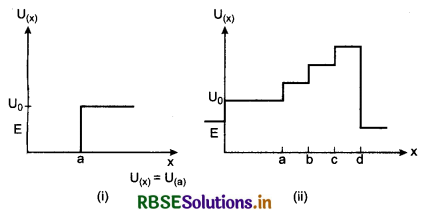
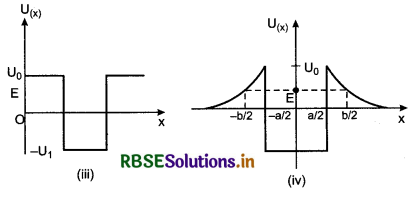
Answer:
Total (mechanical energy) E = kinetic energy K + potential energy U
∴ Kinetic energy K = E - U
Kinetic energy can not be negative, therefore particle can never be found in the region where kinetic energy be negative i.e., E < U
(i) For region x < a, E < U0
Therefore kinetic energy will be negative, thus the particle will never be found in region x < a. Minimum total energy Emin = 0. Its physical example is potential step.
(ii) For every region E < U0. Therefore particle will not be found in region - ∞ < x > ∞.
(iii) In regions x < a and x > b, E < U0
Therefore the particle cannot be found in region x < a and x > b.
Total minimum energy E = -U1
This is the position of certain potential barrier in the region a ≤ x ≤ b
(iv) In the regions \(-\frac{b}{2}<x<-\frac{a}{2}\) and \(\frac{a}{2}<x<-\frac{b}{2}\), E < Ub Therefore particle cannot be found in these regions.
Total minimum energy Eminimuin = -U1
Question 6.4.
The potential energy function for a particle executing linear simple harmonic motion is given by U(x) = \(\frac{1}{2}\)kx2, where k is the force constant of the oscillator. For k = 0.5 N.m-1, the graph of U(x) versus x is shown in figure. Show that a particle of total energy 1 J moving under this potential must ‘turn back’ when it reaches x = ± 2 m.
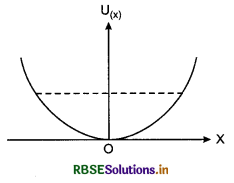
Answer:
Given: Potential energy
U(x) = \(\frac{1}{2}\) kx2
∴ Force F = \(-\frac{d U}{d x}=-\frac{d}{d x}\left(\frac{1}{2} k x^2\right)\)
or F = -kx
It means a linear restoring force acts on the particle and tries to bring the particle in its mean position. The particle returns back from the point where its instantaneous velocity (or kinetic energy) becomes zero.
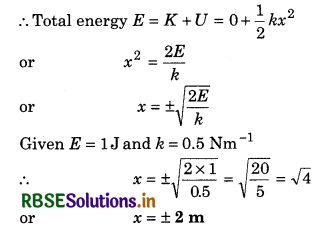
Question 6.5.
Answer the following:
(a) The casing of a rocket in flight burns up due to friction. At whose expense is the heat energy required for burning obtained? The rocket or the atmosphere?
(b) Comets move around the sun in highly elliptical orbits. The gravitational force on the comet due to the sun is not normal to the comet’s velocity in general. Yet the work done by the gravitational force over every complete orbit of the coment is zero. Why?
(c) An artificial satellite orbiting the earth in very thin atmosphere loses its energy gradually due to dissipation against atmospheric resistance, however small. Why then does its speed increase progressively as it comes closer and closer to the earth?
(d) In figure (i) the man walks 2 m carrying a mass of 15 kg on his hands. In figure (ii) he walks the same distance pulling the rope behind him. The rope goes over a pulley, and a mass of 15 kg hangs at its other end. In which situation, work done is more?
Answer:
(a) Heat energy required for burning of the casing of a rocket in flight is obtained from the rocket itself. It is obtained at the expense of the mass of the rocket and its kinetic and potnetial energies.
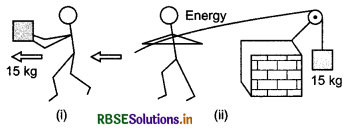
(b) The gravitational force acting on the comet is a conservative force and under influence of conservative force, the work done is equal to change in potential energy for one complete revolution of comet around the sun, change in potential energy is zero whatever be the closed orbit of the comet. This is why work by gravitational force in one complete revolution of comet is zero.
(c) When a satellite becomes closer and closer to earth, its distance r from the centre of the earth goes on decreasing, as a result is potential energy U = \(\frac{-G M_e m}{r}\) goes on decreasing while kinetic energy K = \(\frac{G M_e m}{2 r}\) goes on increasing. Total energy the satellite decreases due of doing work against the friction in atmosphere.
(d) Work done in second situation will be more because on walking by the man, the weight attached with the rope raise due to which its potential energy increases. Therefore some additional work is done by the man due to increase in potential energy.

Question 6.6.
Underline the correct alternative:
(a) When a conservative force does positive work on a body, the potential energy of the body increases/decreases/remains unaltered.
(b) Work done by a body against friction always results in a loss of its kinetic/potential energy.
(c) The rate of change of total momentum of a many particle system is proportional to the external force/sum of the internal forces on the system.
(d) In an inelastic collision of two bodies, the quantities which do not change after the collision are the total kinetic energy/total linear momentum/total energy of the system of two bodies.
Answer:
(a) When a conservative force does positive work on a body, then potential energy of the body decreases.
(b) For doing work against the force of friction, the kinetic energy of the body decreases.
(c) Since internal forces always produce in pairs of equal and opposite forces, therefore internal forces can not change the linear momentum of the system of many particles. Hence rate of change of total momentum of a many particle system is directly proportional to external force.
(d) In a non-elastic collision, total linear momentum remains unchanged but for isolated system, its total energy also remains conserved.
Question 6.7.
State if each of the following statements is true or false. Give reasons for your answer:
(a) In an elastic collision of two bodies, the momentum and energy of each body is conserved.
(b) Total energy of a system is always conserved, no matter what internal and external forces on the body are present.
(c) Work done in the motion of a body over a closed loop is zero for every force in nature.
(d) In an inelastic collision, the final kinetic energy is always less than initial kinetic energy of the system.
Answer:
(a) False: Linear momentum and kinetic energy of individual bodies do not remain conserved but total momentum and energy of both bodies remain conserved.
(b) False: Total kinetic energy of the system remains conserved only when the force acting on the system is conservative. In situation of non-conservative force (e.g., frictional force), total energy of the system is not conserved.
(c) False: Work done in closed loop will be zero only when the force is conservative.
(d) General statement is true but in some situations (e.g., explosion of bomb), total final kinetic energy is greater than initial kinetic energy.
Question 6.8.
Answer carefully with reasons:
(a) In an elastic collision of two billiard balls, is the total kinetic energy conserved daring the short time of collision of the balls (ie., when they are in contact)?
(b) Is the total linear momentum conserved during the short time of an elastic collision of two balls?
(c) What are the answers to (a) and (b) for an inelastic collision?
(d) If the potential energy of two billiard balls depends only on separation distance between their centres, is the collision elastic or inelastic? (Note, we are talking here of potential energy corresponding to the force during collision not gravitational potential energy).
Answer:
(a) No; during short time collision, some kinetic energy converted in internal energy of molecules of the balls. When the balls separate after collision, then this internal energy is again converted in kinetic energy of balls.
(b) Yes; During short time collision, total momentum of the sytem remains conserved.
(c) In in elastic collision, the kinetic energy during collisiqn and. after collision does not remain conserved while total momentum remains conserved.
(d) Collision is elastic, because the force present is conservative.
Question 6.9.
A body is initially at rest. It undergoes one-dimensional motion with constant acceleration. The power delivered to it at time t is proportional to:
(i) t1/2; (ii) t; (iii) t3/2; (iv) t2.
Answer:
Acceleration a = \(\frac{d v}{d t}\) = constant
or dv = a dt
On integrating
\(\int_0^v d v=\int_0^t a d t\)
or [v]0v = a [t]0t
or v = at
∵ Power P = Fv
or P = mav = ma at = ma2t
or P ∝ t
i.e., Power is directly proportional to time t.
∴ Option (ii) is correct.
Question 6.10.
A body is moving unidirectionally under the influence of a source of constant power. Its displacement in time t is proportional to:
(i) t1/2; (ii) t; (iii) t3/2; (iv) t2.
Answer:
∵ Power = Force x Velocity = Constant
or P = Fv = constant
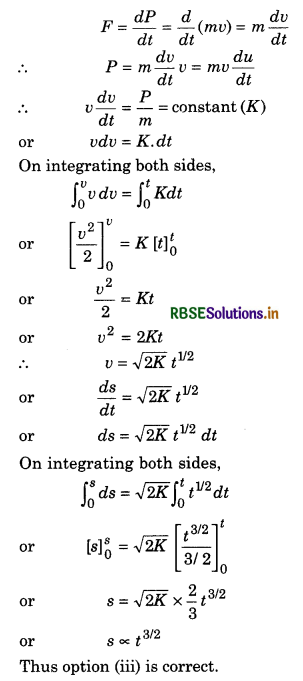
Question 6.11.
A body constrained to move along the z-axis of a coordinate system is subjected to a constant force \(\vec{F}=(-\hat{i}+2 \hat{j}+3 \hat{k})N\), where \(\hat{i}, \hat{j}, \hat{k}\) are unit vectors along x, y, and z axis of the system respectively. What is the work done by this force in moving the body a distance of 4 m along the z-axis?
Answer:
Given: \(\vec{F}=(-\hat{i}+2 \hat{j}+3 \hat{k})\); \(\vec{d} = 4\hat{k}\)
∴ Work done by the force
W = \(\vec{F}.\vec{d} = (-\hat{i}+2 \hat{j}+3 \hat{k}) . (4\hat{k})\)
= -4\(\hat{k}.\hat{i}\) + 8 \(\hat{k}. \hat{j}\) + 12 \(\hat{k}. \hat{k}\)
= 0 + 0 + 12
Because \(\hat{k}.\hat{i} = \hat{k}.\hat{j}\) = 0 and \(\hat{k}.\hat{k}\) = 1
or W = 12 J
Question 6.12.
An electron and a proton are detected in a cosmic ray experiment, the first with kinetic energy 10 keV, and the second with 100 keV. Which is faster, the electron or the proton? Obtain the ratio of their speeds, (electron mass = 9.11 x 10-31 kg, proton mass = 1.67 x 10-27 kg; 1eV = 1.6 x 10-19 J).
Answer:
Kinetic energy of electron,
Ke = \(\frac{1}{2}\) me ve2 = 10 keV
Kinetic energy of proton

Clearly, the velocity of particle is directly proportional to square root of its kinetic energy and inversely proportional to square root of mass of the particle. According to question, the kinetic energy of proton is 10 times to that of electron. While the mass of proton is \(\frac{1.67 \times 10^{-27}}{9.11 \times 10^{-31}}\) = 1833 times the mass of electron. Therefore the speed of electron will be more that of proton.
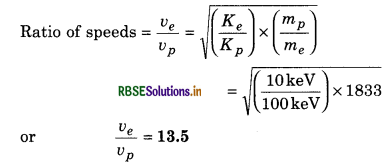
Although, the kinetic energy of proton is more than that of electron, even then the speed of electron is 13.5 times that of proton due to large difference between their masses.

Question 6.13.
A rain drop of radius 2 mm falls from the height of 500 m above the ground. It falls with decreasing acceleration (due to viscous resistance of the air) until at half of its original height, it attains its maximum (terminal) speed and moves with uniform speed thereafter. What is the work done by the gravitational force on the drop in the first and second half of its journey? What is the work done by the resistive force in the entire journey if its speed on reaching the ground is 10 ms-1?
Answer:
Radius of the drop r = 2 mm = 2 x 10-3 m
Density of drop ρ = 103 kg.m-3
volume of the drop v = \(\frac{4}{3}\)πr3
∴ Mass of the drop m = vρ = \(\frac{4}{3}\)πr3ρ
or m = \(\frac{4}{3}\) x 3.14 x (2 x 10-3)3 x (103)
or m = 3.35 x 10-5 kg
Work done by gravitational force is equal to decrease in its gravitational potential energy which is same in both halves equal to 250 m and equal to mgh.
∴ Work done in first half journey
W = mgh = 3.35 x 10-5 x 9.8 x 250
or W = 0.082 J
From law of conservation of energy,
Decay in potential energy = Increase in kinetic energy + Work done against resistive force
or mgH = \(\frac{1}{2}\)mv2 +Wresistive
or Wresistive = mgH - \(\frac{1}{2}\)mv2
Here H = 500 m; v = 10 ms-1
∴ Wresistive = 3.35 x 10-5 x 9.8 x 500 - \(\frac{1}{2}\) x 3.35 x 10-5 x (10)2
= 0.164 - 0.002
= 0.162 J
∴ Work done by reistive force = - 0.162 J
Work done by resitive force is negative because the motion of the drop and resistance forces are in opposite directions.
Question 6.14.
A molecule in a gas container hits a horizontal wall with speed 200 ms-1 at an angle of 30° with the normal and rebounds with the same speed. Is momentum conserved in the collision? Is the collision elastic or inelastic?
Answer:
Initial velocity is along AB direction and final velocity is along BC-direction. Let us assume that X-axis is along the normal on the wall and Y direction is along the wall.
∴ Initial momentum,
\(\vec{P}_1=m v \cos 30^{\circ} \hat{i}-m v \sin 30^{\circ} \hat{j}\)
and final momentum
\(\vec{P}_2=m v \cos 30^{\circ} \hat{i}-m v \sin 30^{\circ} \hat{j}\)
∴ Change in momentum,
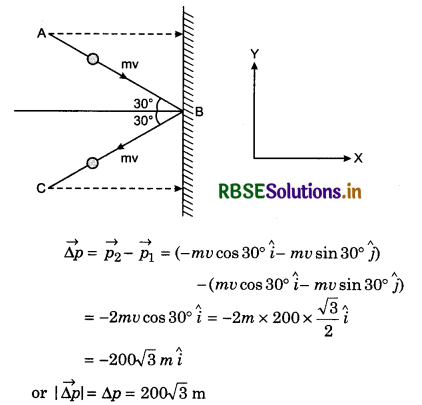
Here m is the mass of the molecule. Direction of change in moment is along - X-axis.
∵ Momentum of (molecule + wall) remains constant and wall is very much heavy, therefore detection of change of momentum of wall is not possible. Also, the kinetic energy remains constant, therefore collision is elastic.
Question 6.15.
A pump on the ground floor of a building can pump up water to fill a tank of volume 30m3 in 15 min. If the tank is 40 m above ground and the efficiency of the pump is 30%, how much electric power is consumed by the pump?
Answer:
Mass of lifted water = volume x density
or m = 30 x 103 = 3 x 104 kg
Height h = 40 m; time t = 15 min = 15 x 60 = 900 s
∴ Work done by the pump,
W = mgh = 3 x 104 x 9.8 x 40 = 1.176 x 107 J
∴ Output power of the pump,
P0 = \(\frac{W}{t}=\frac{1.176 \times 10^7}{900}\) watt
∵ Efficiency of the pump,
η = \(\frac{\text { output power }}{\text { input power }}=\frac{P_0}{P_i}\)
or Pi = \(\frac{P_o}{\eta}=\frac{1.176 \times 10^7 \times 100}{900 \times 30}\)
= 43.6 x 103 watt
∴ Consumed electric power = 43.6 K.watt
Question 6.16.
Two identical ball bearings in contact with each other and resting on a frictionless table are hit head on by another ball bearing of the same mass moving initially with a speed V. If the collision is elastic, which of the figure, following (figure) is possible result after collision?
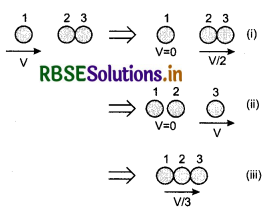
Answer:
In head on elastic collision of two bodies of equal mass, their velocities are interchanged in each other. When ball bearing 1 strikes elastically with ball bearing 2, then it transfers its whole velocity to bearing 2 and it becomes at rest. Now ball bearing 2 strikes with bearing 3 and transferes it whole velocity to bearing 3 and it becomes at rest. Thus the final result that ball bearings 1 and 2 become at rest vand bearing 3 moves with velocity V. Hence situation (ii) is correct.

Question 6.17.
The bob A of a pendulum released from 30° to the vertical hits another bob B of the same mass at rest on the table as shown In figure. How high does the bob A rise after the collision? Neglect the size of the bobs and assume the collision to be elastic.
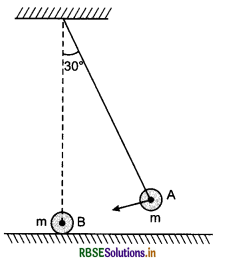
Answer:
When bob A is released, then its potential energy is converted into its kinetic energy. Therefore the velocity of bob A is certain when it reaches under the suspension point. Bob A collides elastically head on with bob B which is at rest and transfers its whole velocity to bob B and itself becomes at rest because both the bobs have same mass. Therefore after collision the bob A rises not least.
Question 6.18.
The bob of a pendulum is released from a horizontal position. If the length of the pendulum is 1.5 m, what is the speed with which the bob arrives at the lowermost point, given that it dissipated 5% of its initial energy against air resistance?
Answer:
Initial kinetic energy of the bob K1 = 0
Initial potential energy of the bob U1 = mgl
∴ Total initial enrgy of the bob
E1 = k1 + U1 = 0 + mgl
or E1 = mgl
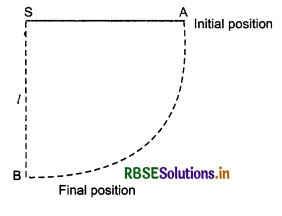
Final kinetic energy of the bob K2 = \(\frac{1}{2}\)mv2 and final potential energy U2 = 0
∴ Total final energy E2 = K2 + U2 = \(\frac{1}{2}\)mv2 + 0
or E2 = \(\frac{1}{2}\) mv2
5% initial energy dissipated
∵ Initial total energy becomes \(\frac{95}{100}\)E1 = \(\frac{95}{100}\) mgl
Now applying the law of conservation of energy,
\(\frac{95}{100}\) mgl = \(\frac{1}{2}\) mv2
or v = \(\sqrt{2 \times \frac{95}{100} g l}=\sqrt{2 \times 0.95 \times 10 \times 1.5}\)
or v = 5.3 ms-1
Question 6.19.
A trolley of mass 300 kg carrying a sand bag of 25 kg is moving uniformly with a speed of 27 kmh-1 on a frictionless track. After a while, sand starts leaking out of a hole on the floor of the trolley at the rate of 0.05 kgs-1. What is the speed of the trolley after the entire sand bag is empty?
Answer:
Since the sand leaks on the floor of the trolley, therefore the mass of the system (trolley + sand bag) remains unchanged. Since external force on the system is zero, therefore momentum of the system remains conserved.
∴ Initial momentum of the system,
Pi = (M + m) v1
where M = mass of the trolley = 300 kg
and m mass of the sand bag = 25 kg
If v2 be the final velocity of the trolley, then final momentum of the system,
Pf = (M + m) v2
∵ Momentum is conserved,
Pf = Pi
or (M + m) v2 = (M + m) v1
or v2 = v1 = 27 km.s-1
Question 6.20.
A body of mass 0.5 kg travels in a straight line with velocity v = a x3/2, where a = 5 m-1/2s-1. What is the work done by the net force during its displacement from x = 0 to x - 2 m?
Answer:
From work-energy theorem
Work = Increase in kinetic energy
or W = \(\frac{1}{2}\) mv22 - \(\frac{1}{2}\)mv12
Given: Mass m = 0.5 kg; a = 5 m-1/2 s-1
At displacement x,
v = ax3/2
At x = 0, velocity = 0
At x = 2m, velocity v2 = a(2)3/2 = 5 x (2)3/2
∴ Work done
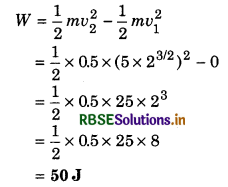
Question 6.21.
The blades of a windmill sweep out a circle of area A. (a) If the wind flows at a velocity v perpendicular to the circle, what is the mass of the air passing through it in time t? (b) What is the kinetic energy of the air? (c) Assume that the wind mill converts 25% of the wind’s energy into electrical energy and that A = 30 m2, v = 36kmh-1 and the density of the air is 1.2 kgm-3, what is the electrical power produced?
Answer:
Given: A= 30 m2; v = 36 km.h-1 = 36 x \(\frac{5}{18}\) = 10ms-1
Density of air ρ = 1.2 kg.m-3
(a) Volume of air passing throw the blades of wind mill per second = Av
∴ Volume of air passing through blades in time t
V = Avt
∴ Mass of the air passing in time t
m = Vρ = Avtρ
or m = Avt ρ
(b) Kinetic energy of air,
K = \(\frac{1}{2}\)mv2 = \(\frac{5}{18}\) (Avtρ) v2
or K = \(\frac{1}{2}\) Aρtv3
(c) Produced electric power
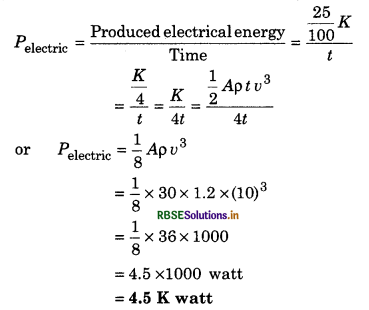
Q.6.22. A person trying to lose weight (dieter) lifts a 10 kg mass, one thousand times, to a height of 0.5 m each time. Assume that the potential energy lost each time she lowers the mass is dissipated, (a) How much work does she do against the gravitational force? (b) Fat supplies 3.8 x 107 J of energy per kilogram which is converted to mechanical energy with efficiency of 20% rate. How much fat will the dieter use up?
Answer:
Given: m = 10kg; h = 0.5 m; g = 9.8 ms-2;
Frequency = 1000 times; efficiency = 20%; Energy of fat = 3.8 x 107 J.kg-1
(a) Work done against gravitational force
W = 1000 x mgh
= 1000 x 10 x 9.8 x 0.5 J
= 4.9 x 104 J
(b) Mechanical energy supplied by 1 kg of fat
= \(\frac{20}{100}\) x 3.8 x 107 = 7.6 x 106 J.kg-1
The fat used up by dieter
= \(\frac{4.9 \times 10^4 \mathrm{~J}}{7.6 \times 10^6 \mathrm{Jkg}^{-1}}\) = 6.45 x 10-3 kg
= 6.45 mg

Question 6.23.
A family uses 8 kW power (a) Direct solar energy is incident on the horizontal surface at an average rate of 200 watt per square meter. If 20% of this energy can be converted to useful electrical energy, how large an area is needed to supply 8 kW? (b) Compare this area to that of the roof of a typical house.
Answer:
(a) If A be the required area, then average power incident on this area = 200 A watt
∴ Useful electrical power,
Pelectrical = \(\frac{20}{100}\) x 200 A = 40A watt
But according to question,
Pelectrical = 8 KW = 8 x 103 watt
∴ 40A = 8 x 103
or A = \(\frac{8 \times 10^3}{40}\) m2 = 200 m2
or A = 200 m2
(b) Area of roof of a typical house = 14 x 14 m2
= 196 m2
∴ The required area is comparable to area of roof of a typical house.
Additional Exercises
Question 6.24.
A bullet of mass 0.012 kg and horizontal speed 70 ms-1 strikes a wooden block of mass 0.4 kg and instantly comes to rest with respect to the block. The block is suspended from the ceiling by means of thin wires. Calculate the height to which the block rises. Also estimate the amount of heat produced in the block.
Answer:
Given: Mass of the bullet m = 0.012 kg
Initial velocity of the bullet u = 70ms-1
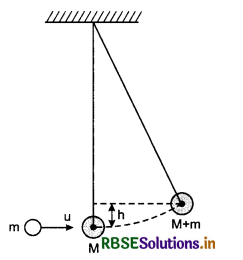
Mass of the wooden block.
M = 0.4 kg
When the bullet strikes the block, it enters in it and remains there. If v be the velocity the system (bullet + block), then from law of conservation of momentum,
mu + 0 = (M + m)v
∴ v = \(\frac{m u}{(M+m)}=\frac{0.012 \times 70}{0.4+0.012}=\frac{0.012 \times 70}{0.412}\)
= 2.04 ms-1
∴ Kinetic energy of the system,
K = \(\frac{1}{2}\) (M+m)v2
and the potential energy of the system at the point from where it returns back.
U = (M + m)gh
∴ From law of conservation of energy
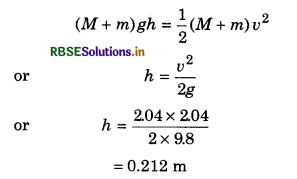
∵ The collision of bullet and the block is perfectly inelastic, therefore some amount of kinetic energy converts into heat.
∴ Heat produced = Initial kinetic energy - Final kinetic energy
or Q = \(\frac{1}{2}\)mv2 - \(\frac{1}{2}\) (M + m)v2
= \(\frac{1}{2}\) x 0.012 x 70 x 70 - \(\frac{1}{2}\) (0.4 + 0.012) x 2.04 x 2.04
= 29.4 - 0.86
= 28.54 J
Question 6.25.
Two inclined frictionless tracks, one gradual and the other steep meet at A from where two stones are allowed to slide down from rest, one on each track (figure). Will the stones reach the bottom at the same time? Will they reach there with the same speed? Explain. Given θ1 = 30° and θ2 = 60° and h = 10 m. What are the speeds and times taken by the two stones?
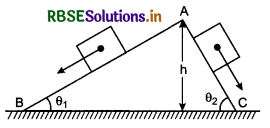
Answer:
Explanation: Length of plane AB = l1 = \(\frac{h}{\sin \theta_1}\) Acceleration of stone one coming down on plane AB
a1 = g sin θ1
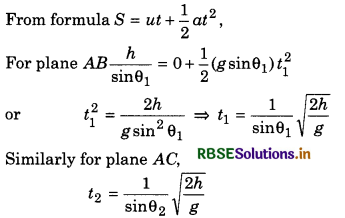
∵ θ1 and θ2 are different, therefore t1 and t2 will also be different.
Now using equation v2 = u2 + 2as
For plane AB, v12 = 0 + 2(g sinθ1)l1
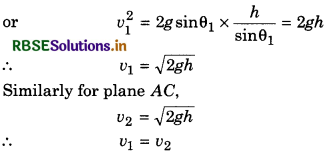
i.e., both the stones will reach the ground with same speeds but at different times.
Calculation: Given θ1 = 30°; θ2 = 60°; h = 10 m and g = 10 ms-2
Time t1 = \(\frac{1}{\sin \theta_1} \sqrt{\frac{2 h}{g}}=\frac{1}{\sin 30^{\circ}} \sqrt{\frac{2 \times 10}{10}}=\frac{1}{1 / 2} \sqrt{2}\)
or t1 = 2\(\sqrt{2}\) s
Time t2 = \(\frac{1}{\sin \theta_2} \sqrt{\frac{2 h}{g}}=\frac{1}{\sin 60^{\circ}} \sqrt{\frac{2 \times 10}{10}}\)
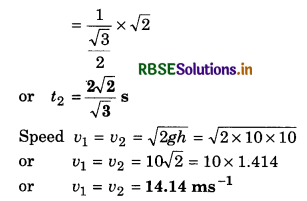

Question 6.26.
A 1 kg block situated on a rough incline is connected to a spring of spring constant 100 Nm-1 as shown in figure. The block is released from rest with the spring in unstretched position. The block moves 10 cm down the incline before coming to rest. Find the coefficient of friction between the block and incline. Assume that the spring has negligible mass and the pulley is frictionless.
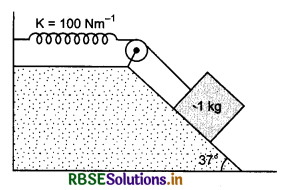
Answer:
Given: sin 37° = \(\frac{3}{5}\) and cos 37° = \(\frac{4}{5}\); m = 1 kg; K = 100 N.m-1; x = 10 m = 0.10 m; µ = ?; g = 10ms-2
When the system is released from rest, then forces acting on the block are shown in figure.
Normal reaction acting on the block, N = mg cos 37°
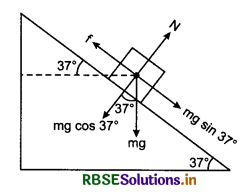
∴ Force of friction
f = µN = µmg cos 37°
If downwards displacement of the block on incline be x, then potential energy of the spring
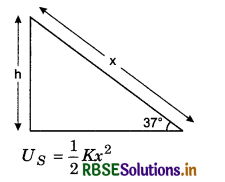
Work done against frictional force,
W = fx
Decay in potential energy of the block,
Uh = mgh
∴ From law of conservation of energy,
Uh = US + W
mgh = \(\frac{1}{2}\).Kx2 + fx
From figure,
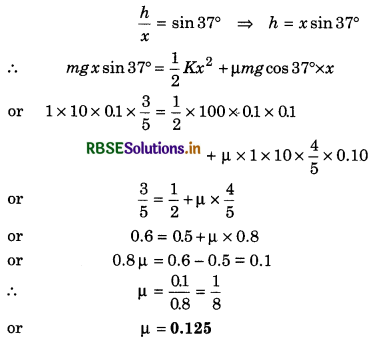
Question 6.27.
A bolt of mass 0.3 kg falls from the ceiling of an elevator moving down with a uniform speed of 7 ms-1. It hits the floor of the elevator (length of the elevator = 3 m) and does not rebound. What is the heat produced by the impact? Would your answer be different if the elevator were stationary?
Answer:
Due to inertia, the initial speed of the bolt will be same as that of the elevator, therefore initial relative speed of the bolt with respect to elevator is zero. When the bolt falls downwards, its potential enrgy converts into its kinetic energy which ultimately converts in heat.
∴ Heat produced by impact = mgh = 0.3 x 9.8 x 3
= 8.82 J
If the elevator be stationary, then also answer will be the same because initial speed of the bolt will be zero in this situation also.
Question 6.28.
A trolley of mass 200 kg moves with uniform speed of 36 kmh-1 on a frictionless track. A child of mass 20 kg runs on the trolley from one end to the other (10 m away) with a speed of 4 ms-1 relative to the trolley in a direction opposite to its motion and jumps out of the trolley. What is the final speed of the trolley? How much has the trolley moved from the time the child begins to run?
Answer:
Given: Mass of trolley M = 200 kg; mass of child m = 20 kg; velocity of trolley = 36 kmh-1
= 36 x \(\frac{5}{18}\) = 10 ms-1; velocity of child = 4ms-1 (in opposite direction of trolley), momentum of system before the child starts running
= (M + m)u = (200 + 20) x 10 = 2200 kg.m.s-1
When the child runs on the trolley, he provides impulse to trolley, therefore the speed of the trolley is changed. Suppose the new speed of the trolley is v, then relative speed of child with respect to earth
vce = (v - u)
Final momentum of the system (trolley + child)
200v + 20(v - u) = 220 v - 20u
= 220v - 20 x 4 = 220v - 80
∴ According to principle of conservation of momenmtum,
Final momentum = Initial momentum
or 220v - 80 = 2200
or 220v = 2200 + 80 = 2280
∴ v = \(\frac{2280}{220}\)
or v = 10.36 ms-1
Time taken by child in running on the trolley from its one end to other end.
t = \(\frac{\text { distance }}{\text { speed }}=\frac{10 \mathrm{~m}}{4 \mathrm{~ms}^{-1}}\)
or t = 2.5 m
Distance travelled by the trolley in this time
S = vt = 10.36 x 2.5
S = 25.9 m

Question 6.29.
Which of the following potential energy curves (figures) cannot possibly describe the elastic collision of two billiard balls? Here r is the distance between centres of the balls. R is the radius of the balls.
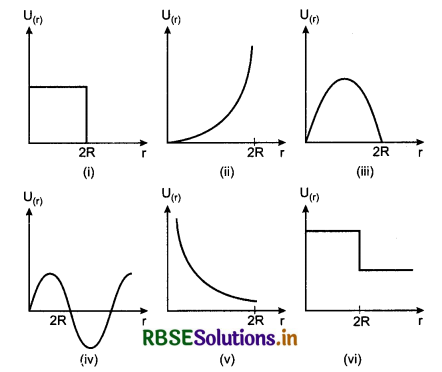
Answer:
Total kinetic energy remains conserved in elastic collision but during actual contact of bodies it may change. At the time of actual contact, the potential energy is maximum and it reduces to zero when they are separated at r = 2R. This condition is satisfied by graph (v) only. Therefore only graph (v) is correct. Rest all graphs do not describe the elastic collision of billiard balls.
Question 6.30.
Consider the decay of a free neutron at rest: n → p + e-
Show that the two body decay of this type must necessarily give an electron of fixed energy, and, therefore, cannot account for the observed continuous energy distribution in the ß-decay of a neutron or a nucleus (figure).
Answer:
Given decay process is
n = p+ + e-
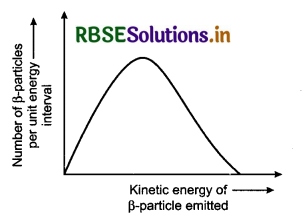
Since neutron is at rest, therefore net momentum of proton and electron must be zero. It means the momentum of electron should be equal and opposite to that of proton.
∵ Kinetic energy = \(\frac{(\text { momentum) })^2}{2 \times \text { mass }}\)
or K = \(\frac{p^2}{2 m}\)
∵ me < mp ∴ Ke > Kp
i.e., kinetic energy of electron will be more than that of proton. Therefore the energy of electron can not be as shown in figure. This contradiction was solved by scientist ‘Pauli’ presenting a hypothesis. He told that emission of ß-particle is accompanied by emission of antineutrino. Thus decay process is as under:

To explain continuous distribution of energy of electron, Pauli assumed that total energy is distributed in electron and neutrino. When energy of electron is zero then that of antineutrino is maximum and vice-versa. Antineutrino is massless and charge less particle. Its intrinsic spin is \(\frac{1}{2}\).
